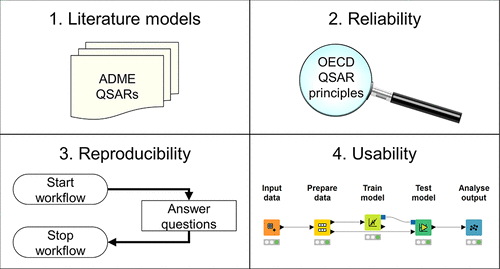当前位置:
X-MOL 学术
›
J. Chem. Inf. Model.
›
论文详情
Our official English website, www.x-mol.net, welcomes your feedback! (Note: you will need to create a separate account there.)
Assessment and Reproducibility of Quantitative Structure–Activity Relationship Models by the Nonexpert
Journal of Chemical Information and Modeling ( IF 5.6 ) Pub Date : 2018-02-09 00:00:00 , DOI: 10.1021/acs.jcim.7b00523 Mukesh Patel 1 , Martyn L. Chilton 1 , Andrea Sartini 1 , Laura Gibson 1 , Chris Barber 1 , Liz Covey-Crump 1 , Katarzyna R. Przybylak 2 , Mark T. D. Cronin 2 , Judith C. Madden 2
Journal of Chemical Information and Modeling ( IF 5.6 ) Pub Date : 2018-02-09 00:00:00 , DOI: 10.1021/acs.jcim.7b00523 Mukesh Patel 1 , Martyn L. Chilton 1 , Andrea Sartini 1 , Laura Gibson 1 , Chris Barber 1 , Liz Covey-Crump 1 , Katarzyna R. Przybylak 2 , Mark T. D. Cronin 2 , Judith C. Madden 2
Affiliation

|
Model reliability is generally assessed and reported as an intrinsic component of quantitative structure–activity relationship (QSAR) publications; it can be evaluated using defined quality criteria such as the Organisation for Economic Cooperation and Development (OECD) principles for the validation of QSARs. However, less emphasis is afforded to the assessment of model reproducibility, particularly by users who may wish to use model outcomes for decision making, but who are not QSAR experts. In this study we identified a range of QSARs in the area of absorption, distribution, metabolism, and elimination (ADME) prediction and assessed their adherence to the OECD principles, as well as investigating their reproducibility by scientists without expertise in QSAR. Here, 85 papers were reviewed, reporting over 80 models for 31 ADME-related endpoints. Of these, 12 models were identified that fulfilled at least 4 of the 5 OECD principles and 3 of these 12 could be readily reproduced. Published QSAR models should aim to meet a standard level of quality and be clearly communicated, ensuring their reproducibility, to progress the uptake of the models in both research and regulatory landscapes. A pragmatic workflow for implementing published QSAR models and recommendations to modellers, for publishing models with greater usability, are presented herein.
中文翻译:

非专家对定量构效关系模型的评估和重现性
通常评估模型的可靠性,并将其报告为定量结构-活性关系(QSAR)出版物的内在组成部分;可以使用已定义的质量标准(例如,经济合作与发展组织(OECD)原则)对它进行评估,以验证QSAR。但是,对模型可重复性的评估较少强调,尤其是那些可能希望使用模型结果进行决策但又不是QSAR专家的用户。在这项研究中,我们在吸收,分布,代谢和消除(ADME)预测方面确定了一系列QSAR,并评估了它们对OECD原理的遵守程度,并研究了没有QSAR专业知识的科学家对它们的可重复性。在这里,共审查了85篇论文,报告了与ADME相关的31个端点的80多个模型。在这些模型中,确定了12个模型,这些模型至少满足了5个经合组织原则中的4个,并且很容易复制这12个模型中的3个。已发布的QSAR模型的目的应是达到标准的质量水平,并进行清晰的沟通,以确保其可重复性,以在研究和监管环境中促进模型的采用。本文介绍了一种实用的工作流程,用于实施已发布的QSAR模型和对建模人员的建议,以发布具有更高可用性的模型。
更新日期:2018-02-09
中文翻译:

非专家对定量构效关系模型的评估和重现性
通常评估模型的可靠性,并将其报告为定量结构-活性关系(QSAR)出版物的内在组成部分;可以使用已定义的质量标准(例如,经济合作与发展组织(OECD)原则)对它进行评估,以验证QSAR。但是,对模型可重复性的评估较少强调,尤其是那些可能希望使用模型结果进行决策但又不是QSAR专家的用户。在这项研究中,我们在吸收,分布,代谢和消除(ADME)预测方面确定了一系列QSAR,并评估了它们对OECD原理的遵守程度,并研究了没有QSAR专业知识的科学家对它们的可重复性。在这里,共审查了85篇论文,报告了与ADME相关的31个端点的80多个模型。在这些模型中,确定了12个模型,这些模型至少满足了5个经合组织原则中的4个,并且很容易复制这12个模型中的3个。已发布的QSAR模型的目的应是达到标准的质量水平,并进行清晰的沟通,以确保其可重复性,以在研究和监管环境中促进模型的采用。本文介绍了一种实用的工作流程,用于实施已发布的QSAR模型和对建模人员的建议,以发布具有更高可用性的模型。


























 京公网安备 11010802027423号
京公网安备 11010802027423号